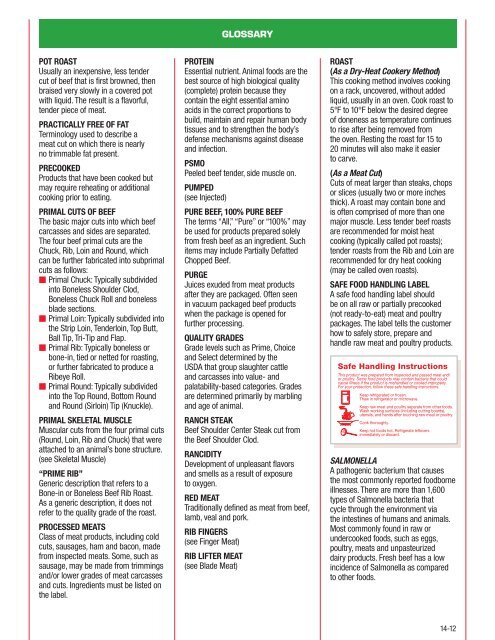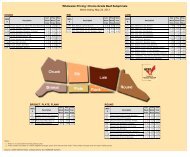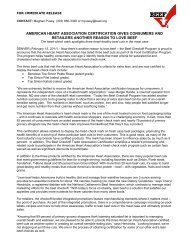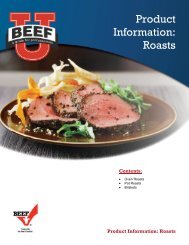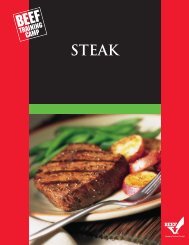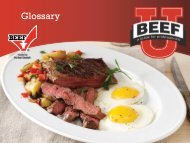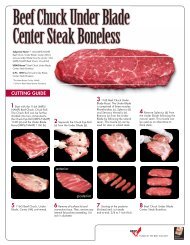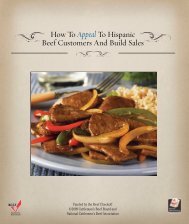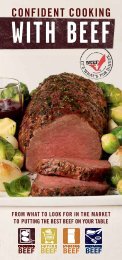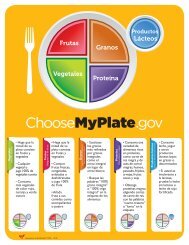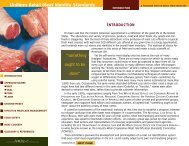NCBA BTC 2 S14 - BeefRetail.org
NCBA BTC 2 S14 - BeefRetail.org
NCBA BTC 2 S14 - BeefRetail.org
Create successful ePaper yourself
Turn your PDF publications into a flip-book with our unique Google optimized e-Paper software.
GLOSSARY<br />
POT ROAST<br />
Usually an inexpensive, less tender<br />
cut of beef that is first browned, then<br />
braised very slowly in a covered pot<br />
with liquid. The result is a flavorful,<br />
tender piece of meat.<br />
PRACTICALLY FREE OF FAT<br />
Terminology used to describe a<br />
meat cut on which there is nearly<br />
no trimmable fat present.<br />
PRECOOKED<br />
Products that have been cooked but<br />
may require reheating or additional<br />
cooking prior to eating.<br />
PRIMAL CUTS OF BEEF<br />
The basic major cuts into which beef<br />
carcasses and sides are separated.<br />
The four beef primal cuts are the<br />
Chuck, Rib, Loin and Round, which<br />
can be further fabricated into subprimal<br />
cuts as follows:<br />
Primal Chuck: Typically subdivided<br />
into Boneless Shoulder Clod,<br />
Boneless Chuck Roll and boneless<br />
blade sections.<br />
Primal Loin: Typically subdivided into<br />
the Strip Loin, Tenderloin, Top Butt,<br />
Ball Tip, Tri-Tip and Flap.<br />
Primal Rib: Typically boneless or<br />
bone-in, tied or netted for roasting,<br />
or further fabricated to produce a<br />
Ribeye Roll.<br />
Primal Round: Typically subdivided<br />
into the Top Round, Bottom Round<br />
and Round (Sirloin) Tip (Knuckle).<br />
PRIMAL SKELETAL MUSCLE<br />
Muscular cuts from the four primal cuts<br />
(Round, Loin, Rib and Chuck) that were<br />
attached to an animal’s bone structure.<br />
(see Skeletal Muscle)<br />
“PRIME RIB”<br />
Generic description that refers to a<br />
Bone-in or Boneless Beef Rib Roast.<br />
As a generic description, it does not<br />
refer to the quality grade of the roast.<br />
PROCESSED MEATS<br />
Class of meat products, including cold<br />
cuts, sausages, ham and bacon, made<br />
from inspected meats. Some, such as<br />
sausage, may be made from trimmings<br />
and/or lower grades of meat carcasses<br />
and cuts. Ingredients must be listed on<br />
the label.<br />
PROTEIN<br />
Essential nutrient. Animal foods are the<br />
best source of high biological quality<br />
(complete) protein because they<br />
contain the eight essential amino<br />
acids in the correct proportions to<br />
build, maintain and repair human body<br />
tissues and to strengthen the body’s<br />
defense mechanisms against disease<br />
and infection.<br />
PSMO<br />
Peeled beef tender, side muscle on.<br />
PUMPED<br />
(see Injected)<br />
PURE BEEF, 100% PURE BEEF<br />
The terms “All,” “Pure” or “100%” may<br />
be used for products prepared solely<br />
from fresh beef as an ingredient. Such<br />
items may include Partially Defatted<br />
Chopped Beef.<br />
PURGE<br />
Juices exuded from meat products<br />
after they are packaged. Often seen<br />
in vacuum packaged beef products<br />
when the package is opened for<br />
further processing.<br />
QUALITY GRADES<br />
Grade levels such as Prime, Choice<br />
and Select determined by the<br />
USDA that group slaughter cattle<br />
and carcasses into value- and<br />
palatability-based categories. Grades<br />
are determined primarily by marbling<br />
and age of animal.<br />
RANCH STEAK<br />
Beef Shoulder Center Steak cut from<br />
the Beef Shoulder Clod.<br />
RANCIDITY<br />
Development of unpleasant flavors<br />
and smells as a result of exposure<br />
to oxygen.<br />
RED MEAT<br />
Traditionally defined as meat from beef,<br />
lamb, veal and pork.<br />
RIB FINGERS<br />
(see Finger Meat)<br />
RIB LIFTER MEAT<br />
(see Blade Meat)<br />
ROAST<br />
(As a Dry-Heat Cookery Method)<br />
This cooking method involves cooking<br />
on a rack, uncovered, without added<br />
liquid, usually in an oven. Cook roast to<br />
5°F to 10°F below the desired degree<br />
of doneness as temperature continues<br />
to rise after being removed from<br />
the oven. Resting the roast for 15 to<br />
20 minutes will also make it easier<br />
to carve.<br />
(As a Meat Cut)<br />
Cuts of meat larger than steaks, chops<br />
or slices (usually two or more inches<br />
thick). A roast may contain bone and<br />
is often comprised of more than one<br />
major muscle. Less tender beef roasts<br />
are recommended for moist heat<br />
cooking (typically called pot roasts);<br />
tender roasts from the Rib and Loin are<br />
recommended for dry heat cooking<br />
(may be called oven roasts).<br />
SAFE FOOD HANDLING LABEL<br />
A safe food handling label should<br />
be on all raw or partially precooked<br />
(not ready-to-eat) meat and poultry<br />
packages. The label tells the customer<br />
how to safely store, prepare and<br />
handle raw meat and poultry products.<br />
Safe Handling Instructions<br />
This product was prepared from inspected and passed meat and/<br />
or poultry. Some food products may contain bacteria that could<br />
cause illness if the product is mishandled or cooked improperly.<br />
For your protection, follow these safe handling instructions.<br />
Keep refrigerated or frozen.<br />
Thaw in refrigerator or microwave.<br />
Keep raw meat and poultry separate from other foods.<br />
Wash working surfaces (including cutting boards),<br />
utensils, and hands after touching raw meat or poultry.<br />
Cook thoroughly.<br />
Keep hot foods hot. Refrigerate leftovers<br />
immediately or discard.<br />
SALMONELLA<br />
A pathogenic bacterium that causes<br />
the most commonly reported foodborne<br />
illnesses. There are more than 1,600<br />
types of Salmonella bacteria that<br />
cycle through the environment via<br />
the intestines of humans and animals.<br />
Most commonly found in raw or<br />
undercooked foods, such as eggs,<br />
poultry, meats and unpasteurized<br />
dairy products. Fresh beef has a low<br />
incidence of Salmonella as compared<br />
to other foods.<br />
14-12


